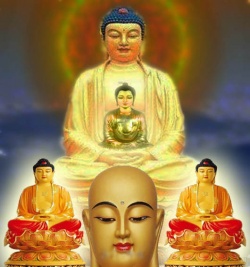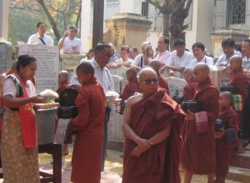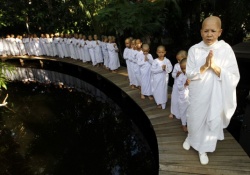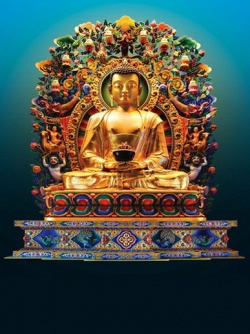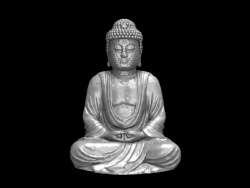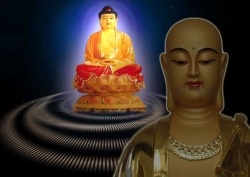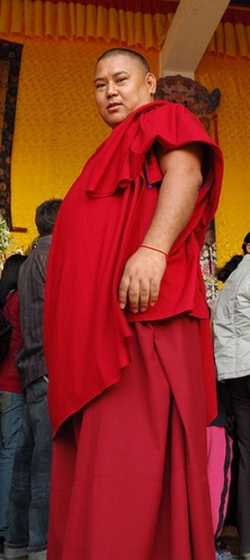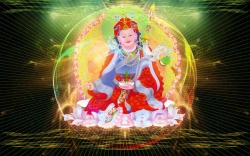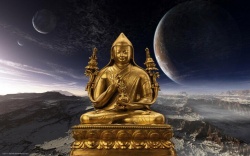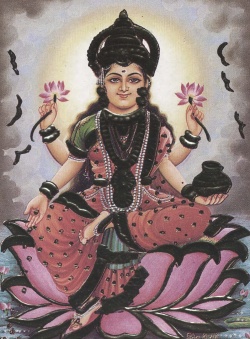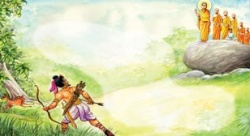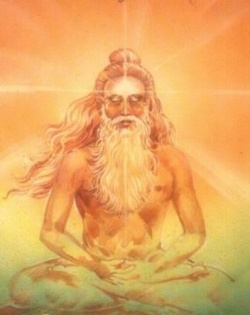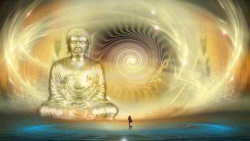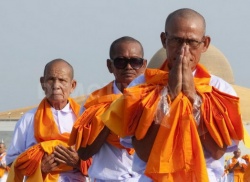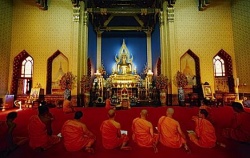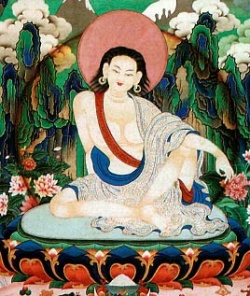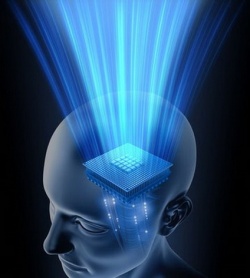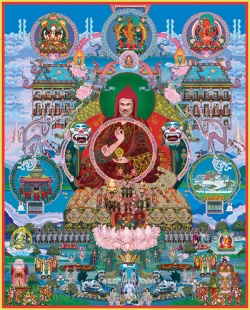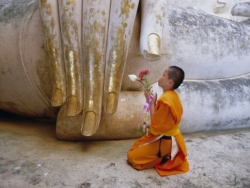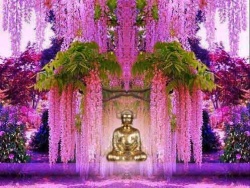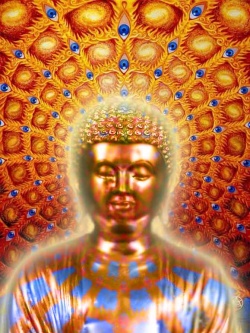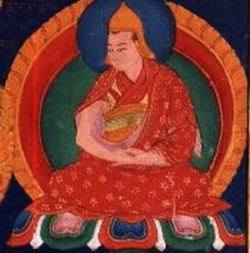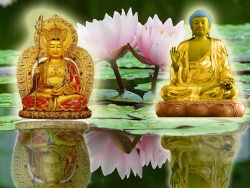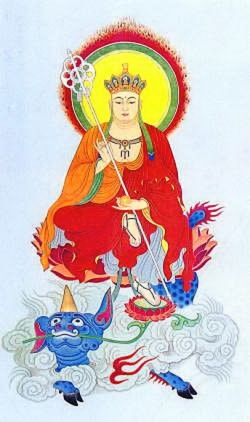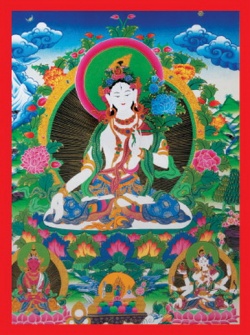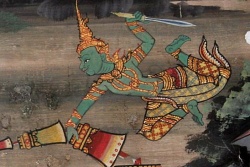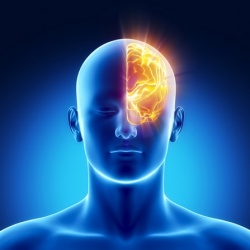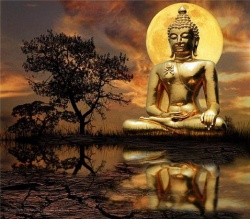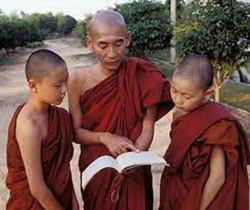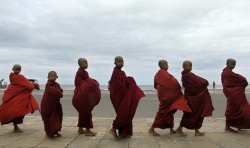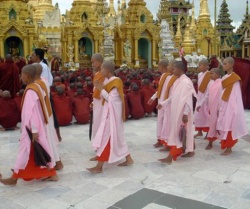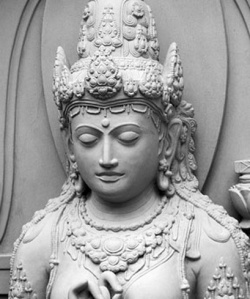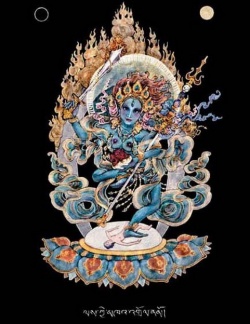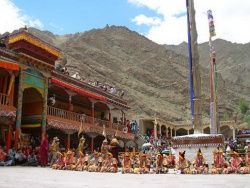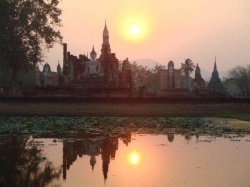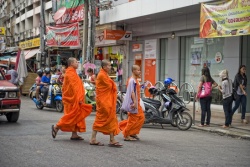Puggalavada and Theravada Buddhist teachings
This revised version of something I wrote back in 2006 initially began as response to a members post, which eventually evolved into a topic in its own right.
This entry is simply an attempt to share some of the things that I found regarding the Puggalavadins, as well as my own thoughts on the subject.
Be honest. How many times have you ever pondered the teachings on not-self (anatta) in an effort to discover whether there's a hidden self (atta) lurking around in the shadows somewhere?
I can admit that I was once interested in pinning down the exact meaning of 'self,' 'not-self,' and whatever was in-between, mainly in an attempt to discover the answer to the timeless question, Who am I?
The difficulties in understanding the Buddha's teachings on rebirth (punabbhava, literally 'again becoming') along with not-self have plagued practitioners since the very beginning of the Buddha's dispensation.
Throughout the beginning of my own journey into Buddhism, I flirted with a version of the Puggalavadin view of self, which was helped along by the fact that I was previously a practicing Pagan with a fairly strong belief in the existence of a type of self or soul already.
However, I quickly discovered a key problem: I was in no position to determine the exact nature of self from the Buddhist point of view when I'd yet to even grasp the basic tenets of Buddhism itself.
So in search of an answer, I turned to the discourses of the Buddha recorded in the Pali Canon, hungrily looking for something I could wrap my intellectual understanding around.
At the beginning, I mistook the meaning of SN 44.10, thinking that perhaps the Buddha was just being coy and hinting at something there that was so unlike what anybody thought was there that it couldn't simply be labelled as 'self.'
But after spending some time with a monk from the Thai Forest tradition, and more time reading the Suttas, I began to realize that the Buddha wasn't hinting at a self or a lack thereof at all; he was simply avoiding the misunderstandings and spectrum of wrong views the issue itself presents.
At that point, I resigned myself to leave the question of self alone, deciding that that was what the Buddha himself recommended thanks to suttas such as AN 4.42 and MN 2.
I could now clearly see that trying to affirm or even deny a self of any sort wouldn't lead me to the cessation of suffering, so what was the point? I realized that whatever the truth may be, it must be 'seen' for oneself.
It's not something that can adequately be put into words without giving the wrong impression, and it's not something that can be understood solely through reason;
it's something that must eventually be experienced. All of the teachings and techniques expounded by the Buddha are ultimately meant to lead to 'knowledge and vision of things as they are' (yatha-bhuta-nana-dassana), and subsequently, to awakening. "Ah, so it's like this."
As for the Puggalavadins, they went by the same collection of teachings (sans the Abhidhamma Pitaka) as the other accepted schools of Buddhism, and they weren't necessarily deemed 'heretical' at the time of their existence.
It's reported that their sect covered much of India before the decline of Buddhism in that area, and the main difference between them and the other sects existent at the time was their interpretation of the Buddha's teaching on not-self.
There was much debate at the time as to what the Buddha was really pointing at in regard to the existence or non-existence of self — that which is "permanent, stable, eternal, not subject to change" (SN 24.3) — with sutta references presented as evidence by both sides.
One of the most famous and contentious is SN 22.22, with its unique mention of the 'person' (puggala) as the "carrier of the burden."
Beyond this debate, however, their methods of practice were, as far as we know, quite similar.
This brings me to my point. It seems that even today, certain teachers in the Theravada tradition have views and teachings that seem to mirror the ancient Puggalavadin's, long after the latter's disappearance.
There are certain teachers in the Thai Forest tradition, for example, whose teachings regarding the purified mind (citta) bear a striking resemblance to the Puggalavadin's regarding the person.
That's not to say that they believe in, or teach about, a 'self' as the Puggalavadins did, but that they teach in a way that does at least seem to leave the question open. Thanissaro Bhikkhu, for example, wrote a controversial essay called
"The Not-self Strategy," which some criticize as being an "eel-wriggling interpretation of anatta as a strategy."
And then there are quotes like this from "Five Piles of Bricks":
Other passages mention a consciousness in this freedom — "without feature or surface, without end,
luminous all around" — lying outside of time and space, experienced when the six sense spheres stop functioning (MN 49). In this it differs from the consciousness-khandha, which depends on the six sense spheres and can be described in such terms as near or far,
past, present, or future. Consciousness without feature is thus the awareness of Awakening.
And the freedom of this awareness carries over even when the awakened person returns to ordinary consciousness.
But there are others who are even more suspect in the eyes of the 'orthodox' Theravadin community, such as Ajahn Maha Boowa, who some accuse of holding more blatantly 'eternalistic' views.
For example, in the appendix to his Arahattamagga Arahattaphala - The Path to Arahantship, he says things like "the true power of the citta's own nature is that it knows and does not die" (99).
The real question is, Are the Puggalavadin's views, albeit subtly, still around today?
To begin with, who exactly were the Puggalavadins?
From what little we do know, they were a sect of Buddhism that arose in about 300 BCE. They broke off from the older Sthaviravadins (part of which eventually evolved into our modern day 'Theravada' tradition).
Their sect was known as the 'Personalist' school because of their belief that, while there is no 'self,' there is a 'person,' which is neither the same as, nor different from, the aggregates (khandhas).
The Puggalavadins more or less accepted and used the same collection of discourses (Sutta Pitaka) and shared the same the monastic rules (Vinaya Pitaka) as the Sthaviravadins, but they didn't accept the Abhidhamma Pitaka, a systematization of certain concepts and terms found throughout the Sutta Pitaka — with additional concepts and terms added in for logical consistency — which was possibly intended to act as a pedagogical tool, as well as an attempt to describe the ultimate nature of reality.
(Many scholars also agree that the Abhidhamma Pitaka is a later addition to the original teachings that gradual developed over several centuries.
This is not only evident from the fact that the Abhidhamma utilizes words that are found nowhere else in the Canon, but also from the fact that each school had their own version, and some, like the Sautrantika school, even rejecting it altogether.)
As with other sects, they did have different versions of certain suttas, but the majority of their canon was apparently close to that of the Sthaviravadins.
This is significant because they had to have comparable texts and/or teachings to be able to debate their views with their Sthaviravadin counterparts without automatically being deemed heretical.
Unfortunately, almost none of their personal texts have survived besides a few poorly translated Chinese versions, so who can say how close their respective canons actually were.
In any case, after time, the 'orthodox' sect of the Sthaviravadins that eventually evolved into what we call Theravada deemed the Puggalavadin's take on the 'person' to be a misinterpretation of what the Buddha taught —
mistaking the Buddha's conventional usage of speech for something metaphysical — and saw their rejection of the Abhidhamma as unorthodox, therefore they were officially labeled as heretical.
Perhaps this was done even earlier, but we know for sure that in the Theravada Abhidhamma (as well as other versions) there's a section dealing with the refutation of heretical views including the Puggalavadin's called the Kathavatthu or Points of Controversy.
An example of such a refutation of from a Sarvastivadin viewpoint is found in Vasubandhu's Abhidharmakosa:
1. THE PERSONALIST CONTROVERSY
Is final deliverance then possible outside this Dharma, and can it be won on the basis of non-Buddhist doctrines? -No, it cannot, for all other teachings are corrupted by false ideas about a 'self’'.
Instead of taking it as a mere conventional term applied to a series of impersonal processes, they believe in a self which is a substance independent of the Skandhas.
But the mere belief in such a self must of necessity generate defilements.
Those who hold it will be forced to pursue life in the Samsaric world, and will be unable to free themselves completely from it
The Personalist thesis first part., But is it not true that a Buddhist school, the Personalists, speak of a Person who is neither identical with the Skandhas, nor different from them? And is not this Person a kind of self?
And yet, as Buddhists they should be able to win deliverance I - We must ask ourselves whether this Person exists as a real entity, i.e.
as one of the separate elements of existence, like the elementary sight-objects, sounds, and so on, which careful analysis reveals; or whether it has a merely nominal existence, which denotes a combination of simple elements,
as 'milk' is a combination of sights, smells, tastes and touchables.
The Personalist. - Why should not either assumption be true?
Vasubandhu - If the Person is a real entity with a nature of its own; it must be different from the elementary data, just as these are different from one another.
It must then be either produced by causes, or unconditioned. In the first case it is not eternal, as you maintain, and you must be able to state its conditions in detail.
In the second case you adopt a clearly non-Buddhistic doctrine, and, in addition, your Person could not do anything, and would be a rather useless hypothesis.
The Person is therefore unlikely to be a real entity. But if you regard it as a mere designation, then your view does not differ in the least from ours.
The Personalist: We claim that there is a Person; but we do not say that he is an entity. Nor do we believe that he exists merely as a designation for the Skandhas.
What we say is that the word 'Person' denotes a kind of structural unity which is found in correlation with the Skandhas of one individual, i.e. with those elements which are actually present, internal to him, and appropriated by him.
The Personalist thesis, second part: The Personalist also teaches that the Person is 'ineffable', that his relation to the elements cannot be defined, that he, is neither identical not non-identical with them.
He distinguishes five kinds of cognizable things the' first three are the conditioned dharmas, i.e. those past, future and present; the fourth is the Unconditioned; and the fifth is the 'ineffable', and refers to the Person. -
But if the Person were quite ineffable, if nothing at all could be stated about it, then one could also not say of it either that it is the fifth category or that it is not!
The Personalist It is perfectly true that the Person is not an object of consciousness. –
Vasubandhu Very well, but then one can never be aware of it; if unaware of it, one cannot cognize it; if it cannot be an object of cognition, how can its existence ever be established? And if one cannot do that, your system falls to pieces. (Vasubandhu then quotes a number of canonical texts, of which I give three here:]
The Bimbisarasutra says: The foolish ignorant common people, putting their trust in words, imagine that there is such a thing as a self.
But there is neither "I" nor "mine".
There are only dhammas, ill at case, future, present and past.' In the Kshudragama the Buddha says to the Brahmin Badari: 'Badari, one who has four holy, truths, he can free himself from all bonds: thought alone defiles, thought alone purifies.
The self has, in fact not the nature of a self. To think that there is a self is a perverted view. There is nowhere here a living being, there is no self, dharmas alone together with their causes do exist. No person can be found in all the Skandhas when examined
And, having seen that a person is inwardly empty, you must also see the outside world as empty. Even those who meditate on emptiness cannot be said to exist.' And another Sutra says:
'Five calamities result from a belief in a self: wrong opinions about the actual status of a self, in individual, a soul; nondistinction from non-Buddhists; one goes astray on a wrong road; thought does not leap forward into emptiness, finds no serenity in it,
does not abide in it, does not resolve upon it; one will never be sufficiently purified to win the qualities of a Saint. '
The Personalist. These texts have no authority for us. They do not form part of our Scriptures.
Vasubandhu: What then is authority behind your system - your sect or the word of the Buddha?
How can you claim the Buddha as your Teacher, how can you be Shakyumuni's sons, if you do not accept all the Buddha's words as binding on you?
The Personalist: The texts you have just quoted are not the Buddha's own words, and they are not in the Scriptures of our school.
Vasubandhu: That is not very convincing. For all the other .schools accept these texts, and they are not in conflict either with other Sutras, or with the Dharma.
This is therefore sheer effrontery on your. part.
And how then, incidentally, do you explain the Sutra which says: 'To mistake for a self that which is not a self, that is a perverted notion, a perverted idea, a perverted opinion.'
The Personalist. The Sutra only says that it is a perversion to mistake a not-self for a self; but it does not say that it is a perversion to recognize a self as a self.
And also: According to your doctrines the Lord could not possibly be omniscient. You say that all thoughts and mental activities change incessantly, and that each mental act lasts only for one moment.
How then can it know all the dharmas? Only an abiding Person can be omniscient.
Vasubandhu. May I point out that then your Person would be eternal, and that contradicts your statements that we cannot say whether he is eternal or not.
And this is how we account for the Buddha's omniscience:
For us the word 'Buddha' is a term denoting a series of momentary events. We do not believe that in one single moment he just knows all the dharmas simultaneously.
The unique feature of his series of momentary mental actions lies in the fact that, by the mere act of turning his mind on anything, there arises immediately a correct and unperverted knowledge of any object whatever, if there should be at the same time the desire to know it. That is the sense in which we speak of -omniscience'.
The Personalist: Why then, if the word 'person' means nothing but the five Skandhas which form the range of grasping did the Lord teach the 'Burden Sutra', which says:
'I will teach you the burden, its taking up, its laying down. and the bearer -of the burden.
The five Skandhas, which am the range of grasping, are the burden. Craving takes up the burden The renunciation of craving lays it down.
The bearer of the burden is the person: this venerable man, with such and such a name born so and so, of such and such a clan, who himself on this or that food, experiences these pleasures and pains, lives for just so long, says here for just so long, terminates his life-span in just this way.'
For, if "person' were only another name for the Skandhas, if 'person' and Skandhas were actually identical then the burden would carry itself and that is absurd.
Vasubandhu: You have misunderstood the message of this Sutra- The Lord speaks of a 'person' here only in order to conform to the usage of the world.
In fact this so-called 'personality' is nothing but a series of consecutive impersonal momentary events, all of them linked to suffering.
But the processes which have taken place in the past cause in those which succeed them. The preceding Skandhas therefore called the 'burden', the subsequent ones Its 'bearer'.
The Personalist: Moreover. another Sutra says: 'One person, when he arises, when he is born in the world, is born for the weal of the many. Who is that one person? It is the Tathagata.'
Vasubandhu: Here again the Lord just conforms to the usage of the world.
For that reason he treats here as a unit that which is in fact a complex; it is quite usual for people to speak of a 'word', although it is in fact a compound of syllables, or of a heap of rice, although it obviously comprises a multiplicity of grains.
In addition, this Sutra says of the person that 'he arises', and that, contrary to your teaching, makes him into something conditioned.
The Personalist: The term ‘arises’ one meaning when applied to the dharmas another when applied to the Person.
A dharma is said to 'arise' because it exists now after not having existed before.
A person, however, is said to 'arise, or to 'be born' when, on rebirth in a certain form, he takes up, or acquires, certain constituents, which make him into 'this man', 'this animal','this ghost', and so on.
It is quite usual to say of a man who has acquired a knowledge of grammar that 'a grammarian is born!, or 'a grammarian has arisen', but that does not mean that he has come from nothing.
The person 'arises' in the sense that he acquires at a certain time a certain series of attributes, in the above quotation those of a Buddha.
Vasubandhu: This explanation has been expressly condemned by the Lord. For He has said:- 'There is action, and there is the retribution of action. But apart from the causally linked sequence of impersonal dharmas there is no one who acts, there is no one who gives up one set of Skandhas, and takes up others instead! In consequence there is no person who gives up his Skandhas at death and takes up others at rebirth.
The Personalist:. Nevertheless, the Person is real, for it has been said: 'To say that the self does not exist, in truth and in reality, is a wrong view.'
Vasubandhu: This is no proof, for it has also been said that to affirm the existence of a self is a wrong view. We Abbhidharmists believe that both the general affirmation and the general negation of a self are extremist views, in accordance with the well-known saying of the Vatsagotra-sutra: 'Those, Amanda, who affirm a self fall into the extreme of the belief in its eternal continuation; those who deny it fall into the extreme of the belief in its eventual annihilation!
The Personalist: If the Person does not exist, who then is it that wanders about in Samsara? It is difficult to see how the Samsara itself can wander about.
Vasubandhu: The correct explanation is, however, quite simple: When a flame burns a piece of wood, one says that it wanders along it; nevertheless there is nothing but a series of flame-moments. Likewise there is a continuous series of processes which incessantly renews itself, and which is falsely called a living being. Impelled by craving, this series is said to 'wander' in Samsara.
The Personalist: If the momentary processes alone exist, how can you explain these words of the Lord, when he said, on recalling one of his former lives: 'This sage Sunetra, who existed in the past, that Sunetra was I.'
All the psycho-physical elements have changed, and it can therefore only be the 'person' that makes the Buddha and Sunetra identical.
Vasubandhu: What in fact is it that the Lord thinks of when he speaks here of 'I'? If, as you say, he means the 'person', then the past 'I' is identical with the present 'I', and your 'person! will be permanent, as against your intentions.
For us, however, the Lord only meant to say that his actually present dharmas are parts of the same continuous series of dharmas as those of Sunetra.
As one says: 'This fire has burned its way to here.' In any case, you assert the existence of a real self, which is of a nature so subtle and elusive, that the Tathagatas alone can see it.
In that case, the Buddhas would become believers in 'I' and 'mine', with all its pernicious consequences for the spiritual life.
They will form an attachment to that part of the universe which they come to consider as their own, and in that way they will be far removed from deliverance.
The Personalist: It is only when, as is the habit of non Buddhists, something which-is not the true Self is mistaken for the true Self, that one will feel affection for that pretended self.
If, however, one sees, as the Buddhas do, the Ineffable Person as the true self, then, because that actually is the true self, no affection for it is thereby engendered.
So back to the question: Are their views still around today? In my opinion, the answer is yes and no.
While some teachers,
like Thanissaro Bhikkhu, tend to be somewhat suspect and are often accused of holding quasi-eternalistic, Puggalavadin-type views by strict traditionalists,
I believe that they're actually teaching wisely by using a variety of skillful means to burn away clinging (upadana) to all forms of self-view equally, from the idea of 'I have a self,' to the idea of 'I have no self,' and everything in between.
And while some of Thanissaro's writings and talks did make me seriously question his approach at first,
I've since come to the conclusion that his teachings aren't at odds with the Buddha, although they do occasionally conflict with what some consider to be Theravadin orthodoxy.
The way in which Thanissaro writes about not-self, while seeming to leave the question of self open, actually lays the question aside altogether. It may appear that he's hinting at a 'self' lurking around somewhere, but in reality, he's going by what the Suttas themselves actually say (e.g., DN 11, MN 2, MN 8, MN 22, SN 22.85, SN 44.10, etc.).
On closer examination, it's clear (to me at least) that he tries to teach people in a way that discourages both attachment to a belief in a self and an attachment to not-self as a substitute.
This might not sound like it makes very much sense, but it's actually quite ingenious.
Many people simply attach to the idea of having no self instead of a self, which the Buddha also warns against:
This is how he attends inappropriately: 'Was I in the past? Was I not in the past? What was I in the past? How was I in the past?
Having been what, what was I in the past? Shall I be in the future? Shall I not be in the future? What shall I be in the future?
How shall I be in the future? Having been what, what shall I be in the future?' Or else he is inwardly perplexed about the immediate present:
'Am I? Am I not? What am I? How am I? Where has this being come from? Where is it bound?'
As he attends inappropriately in this way, one of six kinds of view arises in him:
The view I have a self arises in him as true & established, or the view I have no self... or the view It is precisely by means of self that I perceive self...
or the view It is precisely by means of self that I perceive not-self... or the view It is precisely by means of not-self that I perceive self arises in him as true & established, or else he has a view like this:
This very self of mine — the knower that is sensitive here & there to the ripening of good & bad actions — is the self of mine that is constant, everlasting, eternal, not subject to change, and will stay just as it is for eternity.
This is called a thicket of views, a wilderness of views, a contortion of views, a writhing of views, a fetter of views.
Bound by a fetter of views, the uninstructed run-of-the-mill person is not freed from birth, aging, & death, from sorrow, lamentation, pain, distress, & despair. He is not freed, I tell you, from suffering & stress.
In addition, Thanissaro, contrary to what some might think, never suggests that the teachings on not-self and kamma (literally 'action') don't work together, implying the need for a pseudo-self to have it all make sense.
This is a horrendous but easily cleared up misunderstanding of what he says in his essay "No-self or Not-self?" Far from claiming that the teachings on not-self and kamma don't fit well together, he's simply explaining that this is a perception many people have (i.e.,
they don't seem to fit), especially Westerners with a Judeo-Christian background, when they learn about Buddhism and first encounter these teachings.
More importantly, by laying aside the question of whether or not there's a self altogether, he's attempting to approach the subject in the same way the Buddha does in SN 44.10 since, in his words,
"to hold either that there is a self or that there is no self is to fall into extreme forms of wrong view that make the path of Buddhist practice impossible."
However, there are some who've studied the Puggalavadin's doctrines and views and have actually come out in favour of them, and quite openly in fact. One such person is D. Amarasiri Weeraratne.
In his article Puggalavada and Theravada Buddhist teachings, he writes:
Upto the time of the 2nd Council 200 years after the Buddha, there were no sectarian divisions among Buddhist monks.
The Buddha had permitted the Sangha to change minor rules after his demise, according to the wishes of the fraternity and by a majority decision.
In pursuance of this concession, the monks of the Vajji country well known for its republican form of government called for the adoption of ten minor changes in the Vinaya rules.
The hard core orthodox and conservative monks headed by Revata and Sabbakami resisted these changes.
Hence the conservative elders disallowed these changes.
Consequently, the dissident monks broke away from the conservative elders (The Theras) and established the Mahasanghika Sect and held their own Sangha Council.
Thus came about the first division in the Sangha. The Maha Sanghikas as their name implies constituted the majority of the Sangha.
The Theras constituted a minority of hard core reactionaries who were opposed to an form of change.
Between the 2nd and 3rd Councils 236 years after the Buddha the Conservative Elders (The Theras) broke off into two sects, viz: Vibjjavadins and Sautrantikas.
Almost simultaneously the Mahasangikas also broke off into a sect called Puggalavadin. (Believers in persons.)
The Vibjjavadins broke off into three sects, one of which was the Theravada - the Buddhism we have in Sri Lanka, Burma, Thailand, Cambodia, Laos etc.
Thus you will see that the Puggalavada Sect and the Theravada Sect were the earliest of the sectarian divisions in Buddhism.
Controversy on Abhidhamma
The chief characteristic of the Puggalavada Sect was their rejection of the Abhidharma Pitaka as a teaching of the Buddha.
They maintained that Abhidharma is apocryphal scripture cooked up by the Theravada Elders between the 2nd and 3rd Councils and adopted at the 3rd Council.
The Puggalavadins as well as Sautranitikas rejected the Abhidharma Pitaka and had only 2 Pitakas viz: Sutta and Vinaya Pitakas.
In the Suttas the Buddha speaks of a person who fares on in Sansara, performs good and bad deeds and receives reward or distribution for them.
In fact the entire Sutta Pitaka is based on the assumption that there is a person (puggala) who is subject to the sufferings in Sansara.
The purpose of the Buddha-Dhamma is to eliminate this suffering and help them to attain Nirvana.
The Abhidharma denies the existence of a person or an individual.
It accepts only fleeting thought moments which arise and flash instantly. In this process there is no person or being. The Buddha taught the Suttas to men on earth, referring to a person.
In the Abhidharma he is supposed to have preached to the gods in which he denies the existence of a person or an individual.
In order to bridge the gulf of this inconsistency the Abhidharma scholars invented the theory of two truths.
The Sutras are true in the conventional sense, and the Abhidharma is true in the ultimate sense which is the highest truth.
The Puggalavadins could not accept the theory that the Buddha had taught two kinds of truth. Nowhere had he done so.
The Theravadins cannot quote from any part of the Sutras where he has taught that there are two truths called Sammuti and Paramartha.
Thus they refuted this contention and asserted that the Abhidharma Pitaka is a fabrication and required another concoction to maintain its validity.
It is with the help of this fabrication that Abhidharma scholars reconcile the inconsistency in the Sutra and Abhidharma teachings.
The Southern School of Buddhism
Theravada Buddhism is Abhidharma oriented.
All its commentaries and ancillary literature are written in a way to accommodate the Abidharma. Ven. Buddhagosha asserted that the Abhidharma Pitaka is a teaching of the Buddha. But he himself admitted in the Atthasalini Commentary that there were ancient Sinhala Elders at Anuradhapura who challenged the validity of the Abhidharma Pitaka.
They pointed out that the Buddha had taught in the Mahaparinirvana Sutra that we should not accept teachings presented to us in his name if they are inconsistent with the Sutra and the Vinaya teachings.
They also asserted that in the Anagatabhaya Sutra the Buddha envisaged a time when monks will cook up doctrines and scriptures not taught by him and present them as the Buddha-word.
He admonished his followers to carefully compare such teachings with the Sutras and the Vinaya and accept them only if they are compatible and consistent.
Therefore Abhidharma being incompatible with the Sutra and Vinaya teaching was rejected by the Puggalawadins.
The Sautrantika teachers too rejected the Abhidharma on the same grounds. The very name Sautrantika Sect means those who take only the Sutras as authoritative.
The controversy on Antarbhava
They accepted Abhidharma only to the extent that it is found in seed form in the Sutras.
Another important teaching of the Puggalavadins was the doctrine of Antarabhava. The interim spirit existence between one life and another.
This was denied by the Therevadins who asserted that the acceptance of Antarabhava by the Puggalavadins was due to a misunderstanding of some passages of the Sutras.
The Puggalavadins maintained their position and showed that the misinterpretation of key passages is the work of Abhidharma oriented Theravada teachers, who tried to cut and hack the Buddha-word to suit their Abhidharma-oriented views.
Their teaching was that their was no person, or being, but a mere flux of fleeting thought moments which are impersonal.
The Puggalavadins considered this a bovine folly.
Between the 2nd and 3rd Council, the Theravadins had compiled 7 Abhidharma books and asserted that except one other were the teachings of the Buddha preached in the Tavatismsa heaven to the gods.
Not to be outdone the Sarvastivadin teachers also compiled 7 Abhidharma books and adopted them as their Abhidharma Pitaka.
They were candid and frank enough to reveal the names of the authors of the books, unlike the Theravadins who took up the position that their 7 books contained preachings of the Buddha to the gods in the Tavatimsa heaven.
The common denominator
But an examination of the two Abhidharma Pitakas show too many discrepancies whereas their Sutra and Vinaya Pitakas are similar.
This is clear proof that the Abhidharma Pitaka was composed after the monks broke off into sects.
The Puggalavadins taught that a person or a pudgala who performs good and bad deeds reaps the results and fares on in Sansara until the attainment of Nirvana.
The Bharahara Surta was the favourite text of the Pudgalavadins.
Therein Buddha said" Bhara have Panchakkhando, Bharaharo Ca Puggalo." This means the five aggregates are a burden, the puggala or person is the burden bearer.
Here clearly the Buddha distinguishes between the five groups of aggregates (skandas) and the person who bears them. But according to the Theravada Abhidharma the burden carries itself.
There is no burden-bearer.
This is what Buddhaghosha meant when he said in the Visuddhi Magga - the standard text of the Theravada - that" there is mere suffering but no sufferer exists".
"There is the Noble Eightfold Path but no one traverses it".
Buddhaghosha copied the idea from a verse in Nagarjuna’s Mula Madhyama Karika - his magnum opus in which he ennunciates his Madhyamika philosophy with its central doctrine of Sunyata - the void.
According to this, the whole world and all its phenomena are mirage, a dream, an illusion or" a castle in the air" as Nagarjuna put it. This is the Hindu doctrine of Maya dressed up in a Buddhist garb.
The Puggalavadins taught that to deny the existence of a person is to bring down the whole edifice of the Buddha-Dharma.
It is absurd to say that the burden carries itself, that mere suffering exists and there is no sufferer, or that the Path exists without anyone to tread the path. This is not Buddhism, it is the Buddhaghosha brand of Abhidharma Buddhism.
The self and no-self
The Puggalavadins point out that if there are no beings, the practise of Metta would not be possible, Karma and Rebirth would be meaningless, without a person faring on in Sansara.
Memories of previous lives, the preaching of the Satipattana Sutra for the purification of beings and overcoming their sufferings would be meaningless, if there is no person.
The Buddha said, "One person is born among men for the welfare and happiness of beings". Hundreds of such texts can be quoted from the Sutras.
To deny a person in the ultimate sense (the highest truth) and accept him in a conventional sense is to talk with two tongues and dilute the truth of the Buddha-word. The Sutta Nipata says that "Buddhas have no two words."
"Truth is one and not many". (Ekam hi saccam na dutiyamatthi). Two contrary truths is foreign to the Buddha’s teaching.
The chief difference between Puggalavada and Theravada comes with the acceptance and non-acceptance of the Abhidharma Pitaka as a teaching of the Buddha.
Theravada is steeped in Abhidharma and is abhidharma oriented. The Puggala vadins have only two Pitakas namely Sutra and Vinaya Pitakas.
The Puggalavadins took care not to use the word Atman or soul as is understood in Vedanta, i.e. an immutable self characterised by permanence, bliss and substance.
The Puggala of the Pudgalavadins is a self that is subject to impermanence, unsatisfactoriness and is not to be considered as the essence or core for those reasons.
This appears to be a halfway house between the Vedantic soul and the no-soul doctrine of the Theravadins.
The Buddha is neither an anatmavadi nor atmavadi.
The Puggalavadins teach that the puggala arises simultaneously with the five aggregates, is not within or outside them, but forms a structural unit with them.
It is the astral body, secondary body or bio-plasamabody of modern Para-psychological research.
Its existence and verifiability has been vindicated by 150 years of Psychical Research in the West in which very eminent scientists have taken part. It is the mano-kaya or the Suttas.
If Buddhism is to be a practical religion of value to mankind, it must take into account and recognise the existence of persons or individuals - otherwise Buddhism falls flat and collapses like a pack of cards.
When you deny a person, you have to deny the Buddha, his Dhamma and the Sangha.
That reduces Buddhism to a force.
As for myself, I try to look at it from the perspective of, In the end, who really knows? If we were to conclude now what the answer may be, without the insights born of the practice itself, it'd be little more than speculation; there'd be no 'gnosis,' no knowledge of the truth.
And we're never asked by the Buddha to speculate about what he meant, nor are we told that we'll be freed by our conceptual thoughts of such.
All that does is lead to what the Buddha called "a thicket of view" and to the propagation of those views (a mental form of samsara, literally 'wandering on').
In fact, I think the Suttas are quite clear that, as important as having an intellectual understanding of the teachings is, people who are serious about ending suffering will eventually need to put these teachings into practice to see whether they really do lead to a true and lasting happiness.
Simply clinging to views of self certainly won't do it.
And what is clinging/sustenance?
These four are clingings: sensuality clinging, view clinging, precept & practice clinging, and doctrine of self clinging.
This is called clinging. (SN 12.2)
And with clinging comes what?
From ignorance as a requisite condition come fabrications.
From fabrications as a requisite condition comes consciousness. From consciousness as a requisite condition comes name-&-form.
From name-&-form as a requisite condition come the six sense media. From the six sense media as a requisite condition comes contact.
From contact as a requisite condition comes feeling. From feeling as a requisite condition comes craving. From craving as a requisite condition comes clinging/sustenance.
From clinging/sustenance as a requisite condition comes becoming. From becoming as a requisite condition comes birth.
From birth as a requisite condition, then aging & death, sorrow, lamentation, pain, distress, & despair come into play. Such is the origination of this entire mass of stress & suffering. (SN 12.2)
That's right, stress and suffering (dukkha) eventually arises due to the sustenance of clinging. That's the danger of clinging, even to the idea of 'self' if such a thing exists.
And this is important because the Buddha himself said that he didn't "envision a clinging to a doctrine of self, clinging to which there would not arise sorrow, lamentation, pain, grief, & despair"(MN 22). And the Buddha only taught one thing:
Both formerly and now, monks, I declare only stress and the cessation of stress.
What this says to me is that, when we travel the path to put down all of our burdens, we must be careful not pick up more along the way. This includes the burden of self-view in any of its subtle forms. That's where the Puggalavadins seem to go wrong in one respect.
Their views, whether right or wrong in the ultimate sense, are sustenance for clinging, especially if we see that the idea of a 'person' beyond the conventional sense is, for all intents and purposes, a doctrine of self.
And while their interpretation of the teachings on not-self does offer a possible explanation of how kamma and rebirth work, they fail in keeping to the Buddha's overall teachings.
In just these three lines, the Buddha leaves no ground for any type of self-view to gain a foothold:
- Sabbe sankhara dukkha. (All processes are stressful.)
- Sabbe sankhara anicca. (All processes are inconstant.)
- Sabbe dhamma anatta. (All phenomena are not-self.)
For us unawakened worldlings (puthujjana), it seems that the quest continues. We each undertake this journey with the hope of finding out these answers for ourselves, to find our own freedom from dukkha.
There's not much certainty in this world, even in Buddhism it sometimes seems, but there's one thing that I think we can have confidence in—the noble eightfold path.
I've come to the conclusion that the answer to the question, Who am I? isn't important.
What's really important, however, is realizing that our attachment to views and doctrines of self keep us rooted in "perceptions and categories of objectification" that continually assail us and our mental well-being (MN 18).
One must clear away all views, opinions and preconceived notions about self, and cut at the very roots of such attachments to gain release.
It's through a combination of meditation and contemplation of the five aggregates that we can develop the insight into the teachings on not-self that's beyond mere speculation, and rests instead within the realm of direct experience.
That kind of insight is the only kind that leads to real freedom, not simply repeating the formula, 'All things are not-self.'
Source
http://newbuddhist.com/discussion/854/puggalavada-a-brief-look
